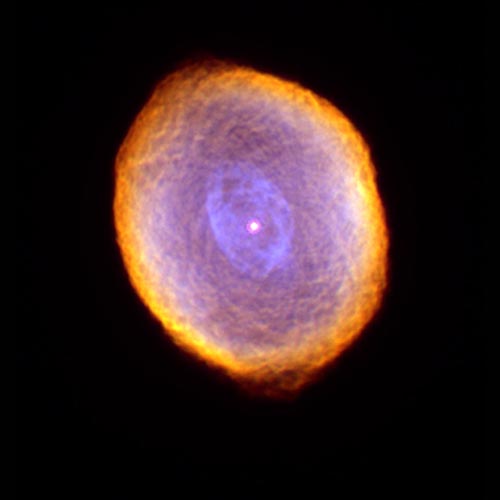
Description: Planetary Nebula in the Milky Way Galaxy
Position: R.A. 05h 27m 28.2s Dec. -12° 41' 50"
Constellation: Lepus
Mean Surface Scale: The nebula is about 0.2 light-years or 13,000 AU
(18 arcseconds) in diameter
Distance: About 2000 light-years
Instrument: WFPC2
Exposure Date(s): February 1999 (F656N - Sahai), September 1999
(F502N, F658N - Hajian)
Exposure Time: 35 minutes
Image Credit: NASA and The Hubble Heritage Team (STScI/AURA)
Release Date: September 7, 2000
ABOUT THIS IMAGE:
Glowing like a multi-faceted
jewel, the planetary nebula IC 418 lies about 2,000 light-years from Earth
in the direction of the
constellation Lepus. This photograph is one of the latest from NASA's
Hubble Space Telescope, obtained with the Wide Field
Planetary Camera 2.
A planetary nebula
represents the final stage in the evolution of a star similar to our Sun.
The star at the center of IC 418 was
a red giant a few thousand years ago, but then ejected its outer layers
into space to form the nebula, which has now expanded
to a diameter of about 0.1 light-year. The stellar remnant at the center
is the hot core of the red giant, from which ultraviolet
radiation floods out into the surrounding gas, causing it to fluoresce.
Over the next several thousand years, the nebula will
gradually disperse into space, and then the star will cool and fade away
for billions of years as a white dwarf. Our own Sun is
expected to undergo a similar fate, but fortunately this will not occur
until some 5 billion years from now.
The Hubble image of
IC 418 is shown in a false-color representation, based on Wide Field Planetary
Camera 2 exposures taken
in February and September, 1999 through filters that isolate light from
various chemical elements. Red shows emission from
ionized nitrogen (the coolest gas in the nebula, located furthest from
the hot nucleus), green shows emission from hydrogen,
and blue traces the emission from ionized oxygen (the hottest gas, closest
to the central star). The remarkable textures seen
in the nebula are newly revealed by the Hubble telescope, and their origin
is still uncertain.
Filters: Red:
F658N [N II] Green:
F656N Ha Blue:
F502N [O III]